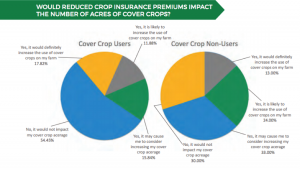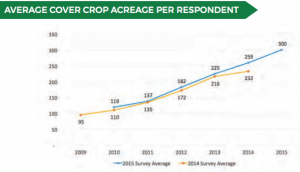For the third year in a row, the results of an annual cover crop survey of farmers around the country confirm the benefits and expansion of cover crops on U.S. cropland.
USDA’s Sustainable Agriculture Research and Education (SARE) program recently released the results of the 2014-2015 Cover Crop Survey, which assessed the benefits, challenges, and scale of adoption of cover crops, as well as demand for cover crop seed across the United States. The Conservation Technology Information Center (CTIC) conducted the Cover Crop Survey with funding from USDA’s SARE program and the American Seed Trade Association.
This year’s online survey had more than 2,472 people answer at least some portion of the survey questions, and had complete responses from 1,229 respondents, which represented 47 states. Of the 1,702 farmers who responded to question of whether they had ever used cover crops on their farm, 84 percent reported that they had.
The results of the survey confirm that farmers are seeing multiple benefits from cover crops, including increased yields of corn and soybeans following the use of a cover crop. When a cover crop was planted before corn, corn yields increased by an average of 3.7 bushels per acre, or 2.1 percent. Farmers who planted a cover crop before planting soybeans saw an average soybean yield increase of 2.2 bushels per acre, or 4.2 percent.
These yield increases, while significant, are slightly lower than the yield increases found in last year’s Cover Crop Survey (3.1 percent for corn, and 4.3 percent for soy), and are lower than the 2012-2013 Cover Crop Survey yield increases (9.6 percent for corn, and 11.6 percent for soy). This large increase in yield benefits from cover crops following a drought year like 2012 can be explained by the enhanced water retention and increased soil organic matter that occurs on the working lands using cover crops.
Chad Watts, the CTIC program director, points out that many of the nutrient benefits of cover crops—including capturing nutrients before they leach from the root zone, fixing atmospheric nitrogen into the soil, and cycling nutrients for use by later cash crops—remain under-appreciated even by long-time cover crop fans. This “shows us that we have more work to do in communicating these nutrient management benefits.”
Insights amongst Non-Users

2014-2015 SARE Cover Crops Survey, page 34.
Several key findings from this year’s study give valuable insight to policymakers and others into the motivations and factors that non-users say could drive them to adopt cover crops in the future. These include:
- Ninety-two percent of the farmers who do not currently plant cover crops say economic incentives would somewhat or always influence cover crop adoption. Similarly, while about half (46 percent) of cover crop users say they would be motivated to plant more cover crops if the practice reduced their crop insurance premiums, that number increases to 70 percent of non-users who said reduced crop insurance premiums could or would influence them to plant cover crops.
- Nearly three-quarters of cover crop users said the market outlook for cash crop prices would have little to no impact on their decision to plant cover crops, which challenges the assumption that cover crop use is closely tied to commodity prices.
Key Findings
According to the 2015 SARE Cover Crop Survey, the three most-cited benefits among cover crop users of using cover crops were: increased overall soil health (22 percent of respondents), increased soil organic matter (20 percent of respondents), and reduced soil erosion (15 percent of respondents).

2014-2015 SARE Cover Crops Survey, page 9.
Key findings of the SARE survey include:
- The mean amount of experience with cover crops among cover crop users was 7.33 years, based on 1,366 responses to this specific question.
- Cover crop users in this survey projected an average cover crop acreage of 300 acres expected to plant in 2015. Those farmers also reported planting an average of 259 acres in cover crops in 2014 and an average of 225 acres in 2013 – which depicts a steady and significant increase in cover crops on their farms in the past few years, despite lower commodity prices.
- For cover crop non-users, the vast majority of these farmers who responded to the survey employ some type of conservation tillage. Almost 25 percent of the 238 non-users employ continuous no-till, 21 percent use no-till in rotation, 20 percent report using reduced tillage methods, and 7 percent use only vertical tillage. The remaining 28 percent use conventional, full-width tillage.
- When considering cover crop species, cereal grains and grasses were the most used cover crops, planted by 84 percent of the 1,287 cover crop users who answered this specific question. The leading species of cover crop was cereal rye, which accounted for 44 percent of the total 2014 cover crop acres planted and the same percentage projected for 2015 in this survey. Annual ryegrass was the second most widely used species, at 23 percent of the total cover crop acres planted in 2014 and the same percentage projected for 2015.
- 57 percent of the 1,251 respondents reported planting legume cover crops in 2014, with crimson clover as the leading species, at 18 percent of the acres planted in 2014. Other top legume species included winter peas (9 percent of the 2014 acreage), cowpea (6 percent of the 2014 acreage), and red clover (5 percent of the 2014 acreage).
- Cover crop mixes were extremely popular. Of 1,233 respondents who answered a question about planting mixes in 2014 or 2015, 67 percent said they had or would. Cover crop mixes of four or more species were most popular, representing 62,255 acres (26.3 percent) of respondents’ land in 2014 and projected to increase by 31 percent to cover 81,685 acres in 2015.
- The most popular source of cover crop seed among 1,360 cover crop users was “company specializing in cover crop seed sales,” at 36 percent of farmer respondents, followed by “ag input retailers” at 31 percent of farmer respondents. Less common sources were “commodity crop seed dealers” with 13 percent, “another farmer” with 12 percent, and “other” with 9 percent. This year was the first time the survey addressed questions about sourcing for cover crop seed, and these results can help predict buying behavior and business opportunities for cover crop seed specialists moving forward.
- The large majority of respondents are very conscious about the quality of their cover crop seed, seen from the results of the survey question regarding which information on cover crop seed tags was most important. Germination rate led the list with 30 percent; noxious weed content at 29 percent; and purity at 28 percent. Only 9 percent said they do not consider the information on the seed tag.
- Row crop producers identified herbicide as their primary cover crop termination method, at 59 percent of the 934 respondents. Non-chemical means of cover crop termination are more popular amongst vegetable/horticulture crop producers, with nearly half – 49 percent of 269 farmers who answered the question – employing tillage as the primary means of termination.
The Importance of Cover Crops
In addition to the benefits of cover crops described above, research continues to explore the role of cover crops for extreme weather risk management, which is increasingly important due to climate change impacts. Healthy soils are crucial to combating the devastating effects of increased flooding, droughts, and unexpected weather events that we are seeing all over the country. Cover crops work to counter these risks through reducing soil compaction, increasing water retention and infiltration, reducing soil erosion from both wind and water, improving soil organic matter, and sequestering nitrogen. According to USDA NRCS, for each 1 percent increase in soil organic matter, U.S. cropland could store the amount of water that flows over Niagara Falls in 150 days.
The increasing popularity of cover crops has been driven by the important work that SARE has been doing for many years to evaluate, analyze and publicize the benefits of cover cropping. We will continue to partner with USDA and other organizations to promote the widespread adoption of cover crops and advocate for important programs such as SARE.


